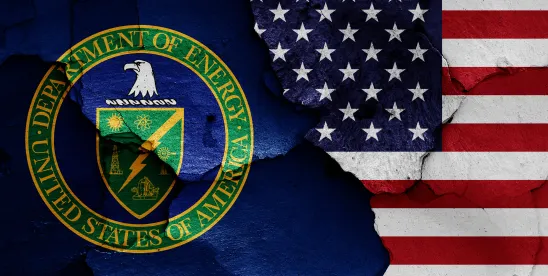Federal Buildings Get New Targets for Clean Energy with DOE Final Rule
The US Department of Energy (DOE) recently finalized a rule to significantly reduce on-site fossil fuel–generated energy consumption in federal buildings with a required reduction of 90% for new construction or major renovations through Fiscal Year 2025 and then a 100% reduction for Fiscal Year 2030 or later. The Clean Energy for New Federal Buildings and Major Renovations of Federal Buildings rule focuses on on-site combustion of fossil fuels only and applies to new construction and major renovations that exceed certain cost thresholds. Click here for the text of the final rule. Full implementation guidance is expected to be issued soon.
Offshore Wind Highlighted in Latest Pathways to Commercial Liftoff Series
A new report from DOE finds that the offshore wind market is at an inflection point, with new projects laying the foundation for “consistent long-term deployment, decarbonization, and economic benefit across the country.” The Pathways to Commercial Liftoff: Offshore Wind report is the latest in a series from DOE intended to “create a common fact base and a tool for ongoing dialogue with the private sector on the pathways to commercial liftoff” for clean energy technologies. Previous Liftoff reports have focused on advanced nuclear power, carbon management, clean hydrogen, industrial carbonization, innovative grid deployment, long duration energy storage, next-generation geothermal power, and virtual power plants.
The administration has also released a new interagency fact sheet describing key federal resources available to support offshore wind development.
DOE Simplifies NEPA Process for Some Projects
A final rule from DOE amends the list of categories of projects that qualify for the simplest form of review under the National Environmental Policy Act (NEPA) based on a lack of significant environmental impacts — in support of the Biden administration’s goal to promote the development of clean energy and supporting infrastructure. The simplified environmental review process includes certain energy storage systems such as battery systems, transmission line upgrades, and solar photovoltaic systems. The aim of the new simplified process is to reduce the cost of environmental analysis incurred by DOE, project developers, and the public.
Biden Administration Announces $54 Million Available for Electric Mobility
With funding provided by the Inflation Reduction Act, the Biden administration has announced a new $54 million funding opportunity through the Communities Taking Charge Accelerator, which is aimed at expanding community e-mobility access and providing clean reliable energy. The funding is administered by the Joint Office of Energy & Transportation through DOE’s Office of Energy Efficiency and Renewable Energy. Topic areas include:
- Solving for No-Home Charging: Expanding Charging Access for Privately Owned E-Mobility
- Expanding E-Mobility Solutions through Electrified Micro, Light and Medium-Duty Fleets
- Managed Charging for Clean Reliable Energy
Concept papers are due May 20, 2024, and full applications are due on July 16, 2024. DOE expects to notify awardees in December 2024, with award negotiations running through April 2025.
EPA Issues Final Rules to Reduce Pollution from Fossil Fuel–Fired Power Plants
The Environmental Protection Agency (EPA) has released four final rules aimed at reducing pollution from fossil fuel–fired plants to reduce climate, air, water, and land pollution from the power sector. The final rules are for:
- Existing coal-fired and new natural gas–fired power plants that would ensure that all coal-fired plants that plan to run in the long-term and all new baseload gas–fired plants control 90 percent of their carbon pollution.
- Strengthening and updating the Mercury and Air Toxics Standards (MATS) for coal-fired power plants, tightening the emissions standard for toxic metals by 67 percent and finalizing a 70 percent reduction in the emissions standard for mercury from existing lignite-fired sources.
- Reducing pollutants discharged through wastewater from coal-fired power plants by more than 660 million pounds per year, ensuring cleaner water for affected communities, including communities with environmental justice concerns that are disproportionately impacted.
- Requiring the safe management of coal ash that is placed in areas that were unregulated at the federal level until now, including at previously used disposal areas that may leak and contaminate groundwater.




 />i
/>i
